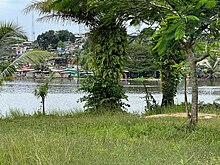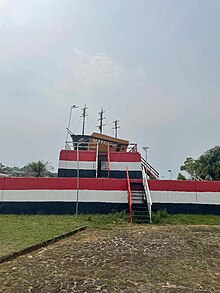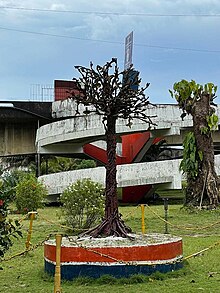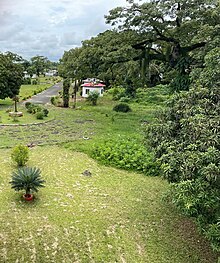


Providence Island (Historically known as Perseverance, Dozoa Island, [1] or Darzoe Island [2]) was the site of the first successful settlement of American freedmen by the American Colonization Society in Liberia. It has been proposed as a UNESCO World Heritage Site by the government of Liberia.
History
After several unsuccessful attempts at colonization (different from Colonialism) along the Pepper Coast, [3] [4] [5] the American Colonization Society sent two agents, Robert F. Stockton and Eli Ayers, to negotiate with local chieftains to secure a place for colonization. [2] [6] A conference was held at Cape Mesurado, which the locals called Ducor. Reaching an agreement, known as the Ducor Contract, the Society acquired the land bounded on the north and west by the Atlantic Ocean and on the south and east by the Mesurado River, including Cape Mesurado and land on Dozoa Island in the bay. [2] [7] [Notes 1] To ensure the validity of the purchase, [Notes 2] Ayers and Stockton ensured that all the surrounding chiefs signed the document. [2] It was executed by Gola chiefs Kaanda Njola of Sao's Town and Long Peter of Klay; Dei chief Kai-Peter of Stockton Creek; Kru chief Bah Gwogro (also George) of Old Kru Town; and chief Jimmy from St. Paul River. [11]


The colonizers established their first settlement in Liberia on Dozoa Island, which they renamed Perseverance and which was later renamed as Providence. In 2017, the Liberian Ministry of Information, Cultural Affairs and Tourism nominated the island for inclusion as a World Heritage Site. [1]
Notes
- ^ Monie Captan argues in his work, Introduction to Liberian Government and Political System: A Civics Textbook that there were two islands at the mouth of the Mesurado River. He concludes that Dozoa was not Providence Island, but rather Bushrod Island, because a historical account by Jehudi Ashmun states that the colonists temporarily stayed on an island owned by John S. Mill (a Mulatto of African and English mixed race descent born in Africa). Captan states that as Mill owned Providence where it was used as a slave Barracoon, it could not have been sold to the Society by the chiefs. [7] However, Mill witnessed the Ducor Contract [8] and anthropology professor, Svend Holsoe, [9] reproduced in his article, A Study of Relations between Settlers and Indigenous Peoples in Western Liberia, 1821-1847 an agreement with Mill signed the day after the Ducor Contract to sell them his property. [10]
- ^ Conflicts later arose, as the chiefs did not understand the concept of ownership or selling land and believed that they had only given the use of the property to the settlers. [8] [6]
References
Notes
- ^ a b Liberian Ministry of Information, Cultural Affairs and Tourism 2017.
- ^ a b c d Holsoe 1971, p. 336.
- ^ Findlay 1867, p. 457.
- ^ Ayatey 1981, p. 150.
- ^ Captan 2015, p. 22.
- ^ a b Captan 2015, p. 23.
- ^ a b Captan 2015, p. 25.
- ^ a b Makain & Foh 2009, p. 9.
- ^ UDaily 2017.
- ^ Holsoe 1971, p. 358.
- ^ Makain & Foh 2009, p. 8.
Works cited
- Ayatey, Shirley H. (Summer 1981). "Reviewed Work: Behold the Promised Land by Tom W. Shick". The Journal of Negro History. 66 (2). Chicago, Illinois: University of Chicago Press: 150–152. doi: 10.2307/2717285. ISSN 0022-2992. JSTOR 2717285. OCLC 7435450701. Retrieved 23 September 2021.
- Captan, Monie R. (2015). Introduction to Liberian Government and Political System: A Civics Textbook. Monrovia, Liberia: Star Books. ISBN 978-9988-2-1441-8.
- Findlay, Alexander G. (1867). A Sailing Directory for the Ethiopic or Southern Atlantic Ocean Including the Coasts of South America and Africa (5th ed.). London: Richard Holmes Laurie.
- Holsoe, Svend E. (1971). "A Study of Relations between Settlers and Indigenous Peoples in Western Liberia, 1821-1847". African Historical Studies. 4 (2). Boston, Massachusetts: African Studies Center, Boston University: 331–362. doi: 10.2307/216421. ISSN 0001-9992. JSTOR 216421. OCLC 5548585910. Retrieved 23 September 2021.
- Liberian Ministry of Information, Cultural Affairs and Tourism (30 March 2017). Providence Island. UNESCO (Report). Paris, France: World Heritage Centre. Reference #6247. Archived from the original on 11 May 2021. Retrieved 24 September 2021.
- Makain, Jeffrey S.; Foh, Momoh S. (2009). "Social Dimension of Large-Scale Land Acquisition Rights in Liberia (1900-2009): Challenges and Prospects for Traditional Settlers". Liberian Studies Journal. 34 (1). Monrovia, Liberia: Liberian Studies Association: 1–40. ISSN 0024-1989. OCLC 701760991. Archived from the original on 30 July 2020. Retrieved 24 September 2021.
- "In Memoriam: Svend Holsoe". UDaily. Newark, Delaware: University of Delaware. 18 May 2017. Archived from the original on 11 July 2020. Retrieved 24 September 2021.



Providence Island (Historically known as Perseverance, Dozoa Island, [1] or Darzoe Island [2]) was the site of the first successful settlement of American freedmen by the American Colonization Society in Liberia. It has been proposed as a UNESCO World Heritage Site by the government of Liberia.
History
After several unsuccessful attempts at colonization (different from Colonialism) along the Pepper Coast, [3] [4] [5] the American Colonization Society sent two agents, Robert F. Stockton and Eli Ayers, to negotiate with local chieftains to secure a place for colonization. [2] [6] A conference was held at Cape Mesurado, which the locals called Ducor. Reaching an agreement, known as the Ducor Contract, the Society acquired the land bounded on the north and west by the Atlantic Ocean and on the south and east by the Mesurado River, including Cape Mesurado and land on Dozoa Island in the bay. [2] [7] [Notes 1] To ensure the validity of the purchase, [Notes 2] Ayers and Stockton ensured that all the surrounding chiefs signed the document. [2] It was executed by Gola chiefs Kaanda Njola of Sao's Town and Long Peter of Klay; Dei chief Kai-Peter of Stockton Creek; Kru chief Bah Gwogro (also George) of Old Kru Town; and chief Jimmy from St. Paul River. [11]


The colonizers established their first settlement in Liberia on Dozoa Island, which they renamed Perseverance and which was later renamed as Providence. In 2017, the Liberian Ministry of Information, Cultural Affairs and Tourism nominated the island for inclusion as a World Heritage Site. [1]
Notes
- ^ Monie Captan argues in his work, Introduction to Liberian Government and Political System: A Civics Textbook that there were two islands at the mouth of the Mesurado River. He concludes that Dozoa was not Providence Island, but rather Bushrod Island, because a historical account by Jehudi Ashmun states that the colonists temporarily stayed on an island owned by John S. Mill (a Mulatto of African and English mixed race descent born in Africa). Captan states that as Mill owned Providence where it was used as a slave Barracoon, it could not have been sold to the Society by the chiefs. [7] However, Mill witnessed the Ducor Contract [8] and anthropology professor, Svend Holsoe, [9] reproduced in his article, A Study of Relations between Settlers and Indigenous Peoples in Western Liberia, 1821-1847 an agreement with Mill signed the day after the Ducor Contract to sell them his property. [10]
- ^ Conflicts later arose, as the chiefs did not understand the concept of ownership or selling land and believed that they had only given the use of the property to the settlers. [8] [6]
References
Notes
- ^ a b Liberian Ministry of Information, Cultural Affairs and Tourism 2017.
- ^ a b c d Holsoe 1971, p. 336.
- ^ Findlay 1867, p. 457.
- ^ Ayatey 1981, p. 150.
- ^ Captan 2015, p. 22.
- ^ a b Captan 2015, p. 23.
- ^ a b Captan 2015, p. 25.
- ^ a b Makain & Foh 2009, p. 9.
- ^ UDaily 2017.
- ^ Holsoe 1971, p. 358.
- ^ Makain & Foh 2009, p. 8.
Works cited
- Ayatey, Shirley H. (Summer 1981). "Reviewed Work: Behold the Promised Land by Tom W. Shick". The Journal of Negro History. 66 (2). Chicago, Illinois: University of Chicago Press: 150–152. doi: 10.2307/2717285. ISSN 0022-2992. JSTOR 2717285. OCLC 7435450701. Retrieved 23 September 2021.
- Captan, Monie R. (2015). Introduction to Liberian Government and Political System: A Civics Textbook. Monrovia, Liberia: Star Books. ISBN 978-9988-2-1441-8.
- Findlay, Alexander G. (1867). A Sailing Directory for the Ethiopic or Southern Atlantic Ocean Including the Coasts of South America and Africa (5th ed.). London: Richard Holmes Laurie.
- Holsoe, Svend E. (1971). "A Study of Relations between Settlers and Indigenous Peoples in Western Liberia, 1821-1847". African Historical Studies. 4 (2). Boston, Massachusetts: African Studies Center, Boston University: 331–362. doi: 10.2307/216421. ISSN 0001-9992. JSTOR 216421. OCLC 5548585910. Retrieved 23 September 2021.
- Liberian Ministry of Information, Cultural Affairs and Tourism (30 March 2017). Providence Island. UNESCO (Report). Paris, France: World Heritage Centre. Reference #6247. Archived from the original on 11 May 2021. Retrieved 24 September 2021.
- Makain, Jeffrey S.; Foh, Momoh S. (2009). "Social Dimension of Large-Scale Land Acquisition Rights in Liberia (1900-2009): Challenges and Prospects for Traditional Settlers". Liberian Studies Journal. 34 (1). Monrovia, Liberia: Liberian Studies Association: 1–40. ISSN 0024-1989. OCLC 701760991. Archived from the original on 30 July 2020. Retrieved 24 September 2021.
- "In Memoriam: Svend Holsoe". UDaily. Newark, Delaware: University of Delaware. 18 May 2017. Archived from the original on 11 July 2020. Retrieved 24 September 2021.